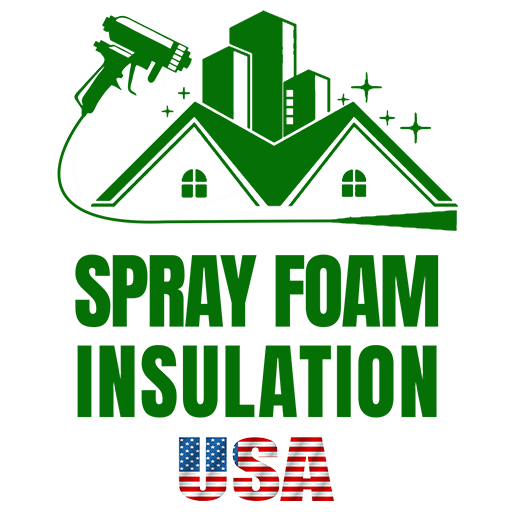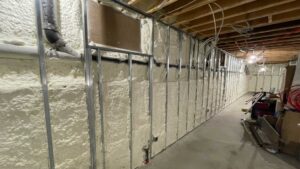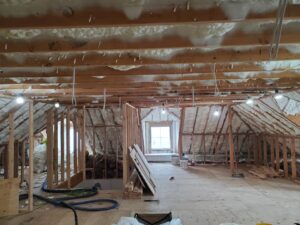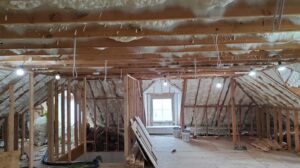When deciding between spray foam insulation and fiberglass for your home or business in NY and NJ, it boils down to finding a balance between cost, energy efficiency, and environmental impact. If you’re looking for a quick answer:
- Spray Foam Insulation: Offers a higher R-value (better insulation), forms an air-tight seal, and is great for preventing moisture. However, it comes with a higher initial cost and concerns regarding its environmental impact.
- Fiberglass Insulation: More affordable and easier to install (DIY-friendly). It’s good for soundproofing but less effective at preventing air leaks and controlling moisture compared to spray foam.
Both insulation types have their pros and cons, with the right choice depending on your specific needs, budget, and values.
In this guide, we’ll lay out all you need to know to make an informed decision between spray foam and fiberglass insulation. Quality insulation isn’t just a barrier to heat loss; it’s a fundamental component of making your space more comfortable, energy-efficient, and environmentally conscious. With the insights from Spray Foam Insulation USA, you’re poised to choose the insulation material that aligns best with your priorities of cutting energy costs, enhancing indoor comfort, and contributing to a healthier planet.

Whether you’re retrofitting an old building or starting fresh, this guide will help you navigate the complexities of choosing the right insulation for enduring comfort and sustainability.
Understanding Insulation Types
When it comes to keeping your home warm in the winter and cool in the summer, not all insulation is created equal. Let’s dive into insulation, focusing on two popular types: spray foam insulation and fiberglass insulation. We’ll look at what makes each unique, including their materials, cost-effectiveness, and overall performance.
Spray Foam Insulation
Imagine spraying a liquid that quickly expands, filling every nook and cranny, and then solidifies. That’s spray foam insulation for you. Made from polyurethane, this type of insulation is a powerhouse when it comes to high R-value, meaning it’s really good at keeping heat from entering or leaving your home.
Spray foam comes in two main types: open-cell and closed-cell. Closed-cell foam is denser and has a higher R-value, making it an excellent choice for areas that need the best insulation possible. Open-cell foam, while not as dense, is still an effective insulator and can be a more affordable option.
Pros:
– High R-value for superior insulation
– Expands to fill gaps, providing an excellent air seal
– Moisture-resistant (especially closed-cell foam)
Fiberglass Insulation
Now, let’s talk about fiberglass insulation. This type is made from fine glass fibers and is one of the most affordable insulation options on the market. It comes in batts and rolls that can be easily cut and fit into the walls, floors, and ceilings of your home.
Fiberglass insulation is a great choice if you’re looking for a cost-effective way to improve your home’s energy efficiency. It’s also DIY-friendly, making it a popular choice for homeowners who want to tackle insulation projects on their own.
Pros:
– Affordable and cost-effective
– Easy to install, making it great for DIY projects
– Good for soundproofing
Spray Foam Insulation vs Fiberglass
| Feature | Spray Foam Insulation | Fiberglass Insulation |
|---|---|---|
| Material | Polyurethane | Glass fibers |
| R-value | High (especially closed-cell foam) | Lower compared to spray foam |
| Cost | Higher initial investment | More affordable |
| Installation | Professional installation recommended | DIY-friendly |
| Moisture Resistance | Excellent (closed-cell) | Poor without proper vapor barriers |
| Air Sealing | Superior | Good, but not as effective as spray foam |
In conclusion, when considering spray foam insulation vs fiberglass, think about what’s most important for your home. If you’re looking for the best insulation possible and are willing to invest more upfront, spray foam is a fantastic choice. Not only does it offer superior thermal resistance, but it also creates an effective moisture barrier.
On the other hand, if you’re on a tighter budget and are looking for a straightforward, cost-effective solution, fiberglass insulation is a solid choice. It’s easier on the wallet and can be a fun weekend DIY project.
The best choice depends on your specific needs, budget, and whether you’re up for a DIY challenge or prefer to leave it to the pros.
Cost Comparison
When it comes to insulating your home, understanding the costs involved is crucial. Both spray foam insulation and fiberglass have their own price tags and savings potential. Let’s break it down.
Spray Foam Insulation Costs
Spray foam insulation, known for its high efficiency and excellent air sealing properties, comes in two main types: open-cell and closed-cell.
- Open-cell spray foam is lighter and less expensive, costing between $0.44 and $0.65 per board foot. It’s ideal for indoor applications where moisture isn’t a big concern.
- Closed-cell spray foam, on the other hand, is denser, offers a higher R-value, and provides moisture resistance. This makes it perfect for areas prone to dampness, like basements and crawl spaces. However, it’s more pricey, with costs ranging from $1 to $1.50 per board foot.
While the initial investment in spray foam might be higher, it’s important to consider the long-term savings. Spray foam insulation can significantly reduce your energy bills by creating an airtight seal that minimizes heat loss. This efficiency can lead to the insulation paying for itself over time through lower heating and cooling costs.
Fiberglass Insulation Costs
Fiberglass insulation is a more budget-friendly option that comes in batts and loose-fill forms.
- Batts, the most common and affordable type, are pre-cut panels that fit between studs and joists in walls and ceilings. They cost between $0.30 and $1.50 per board foot, depending on thickness and quality.
- Loose-fill fiberglass, which is blown into spaces using a special machine, is slightly more expensive, ranging from $1 to $1.50 per board foot. This type is best for attic floors and hard-to-reach areas.
Fiberglass offers cost-effectiveness both in terms of initial purchase and installation. It can be a DIY project for those comfortable with handling insulation, which can save on labor costs. However, while fiberglass insulation provides good thermal resistance, it doesn’t offer the same level of air sealing as spray foam. This means that over time, homes with fiberglass insulation might see higher energy bills compared to those insulated with spray foam.
In Conclusion:
When comparing spray foam insulation vs fiberglass, it’s clear that each has its own set of advantages and considerations. Spray foam, with its higher upfront costs, offers superior insulation and potential energy savings in the long run. Fiberglass, while more affordable initially and DIY-friendly, may not provide the same level of efficiency over time.
Choosing between spray foam and fiberglass will depend on your initial budget, the specific needs of your home, and your long-term energy savings goals. Whether you’re looking to invest more upfront for greater efficiency or seeking a more budget-friendly option, understanding these costs is key to making the right decision for your home.
Investing in insulation is not just about the cost but also about the comfort, energy efficiency, and long-term savings it can bring to your home.
Installation Process
When it comes to insulation, how you get it into your walls, floors, and ceilings is just as important as the type you choose. Let’s dive into the installation process for both spray foam and fiberglass insulation, highlighting the differences in professional requirements, DIY-friendliness, and time consumption.
Installing Spray Foam Insulation
Installing spray foam insulation is not a weekend DIY project. It requires a professional touch for several reasons:
-
Professional Requirement: Due to its complex nature, spray foam must be installed by trained professionals. They have the knowledge and equipment to mix and apply the foam correctly, ensuring it expands and covers every nook and cranny without overexpanding.
-
Equipment: The installation process involves the use of specialized machines that heat and mix two chemical components (isocyanate and polyol resin) before spraying. This equipment is not only expensive but also requires expertise to operate.
-
Time Consumption: While the actual spraying process may be quick, preparation and cleanup can extend the installation time. Areas not being insulated need to be covered to protect them from overspray, and the space needs to be ventilated to clear out any fumes.
Installing Fiberglass Insulation
On the flip side, fiberglass insulation is much more DIY-friendly, making it a popular choice for handy homeowners:
-
DIY-friendly: Installing fiberglass batts or rolls is straightforward. It involves measuring, cutting the material to fit, and then placing it in the desired location. With some basic protective gear (gloves, mask, goggles) and a bit of patience, most people can handle this task.
-
Quick Installation: Compared to spray foam, fiberglass can be installed relatively quickly, especially if you’re working with batts designed to fit standard spaces between joists and studs. There’s no need for the extensive prep work or specialized equipment required for spray foam.
-
Tools and Materials: Besides the insulation itself, you’ll need a few basic tools like a utility knife for cutting the material, a tape measure, and perhaps a staple gun for securing batts. These are tools many homeowners already have, making the barrier to entry much lower than with spray foam.
In summary, the installation process of spray foam insulation vs fiberglass significantly differs in terms of the need for professional help, the time it takes, and the ease of DIY. Spray foam requires a professional team equipped with specialized tools and takes more time due to preparation and cleanup needs. Fiberglass, however, is much more accessible to the average homeowner, offering a quicker and simpler installation process that can be done without professional help. Whatever your preference, understanding these differences is crucial in making the best decision for your insulation needs.
Performance and Efficiency
When it comes to choosing between spray foam insulation and fiberglass, the debate often centers on performance and efficiency. Both have their unique advantages that cater to different needs and preferences. Let’s dive into what makes each option stand out.
Benefits of Spray Foam
- High R-value: Spray foam insulation boasts a higher R-value per inch compared to fiberglass. This means it provides superior thermal resistance, keeping your home warmer in winter and cooler in summer.
- Air Sealing: One of the standout features of spray foam is its ability to create an airtight seal. It expands to fill cracks and gaps, preventing air leakage which is a common issue with traditional insulation materials.
- Energy Efficiency: Due to its high R-value and air sealing capabilities, spray foam insulation contributes significantly to energy efficiency. Homes insulated with spray foam often see a noticeable reduction in their heating and cooling costs.
- Moisture Barrier: Spray foam insulation also acts as an effective moisture barrier. This is particularly beneficial in areas prone to dampness or where water intrusion is a concern. By preventing moisture from entering, it helps protect against mold and mildew growth.
Benefits of Fiberglass
- Cost-effectiveness: Fiberglass insulation is generally less expensive than spray foam, both in terms of material costs and installation. This makes it a popular choice for homeowners looking to improve their home’s insulation on a budget.
- Easy to Replace: If damaged or worn out, fiberglass insulation is relatively easy to replace compared to spray foam. This can be advantageous in situations where insulation needs to be updated or if there’s a need to access areas behind the insulation for repairs.
- DIY-Friendly: Unlike spray foam, which requires professional installation, fiberglass insulation can often be installed by homeowners themselves. This DIY-friendliness can lead to further savings on installation costs.
In summary, if you’re looking for the highest level of energy efficiency and are willing to invest more upfront, spray foam insulation might be the way to go. Its superior R-value, air sealing capabilities, and moisture resistance offer long-term savings and comfort. On the other hand, fiberglass insulation presents a more budget-friendly option that’s easier to handle and replace. It’s a solid choice for those prioritizing cost-effectiveness and ease of installation.
As we move into the next section, keep these performance and efficiency factors in mind. They play a crucial role in determining the overall effectiveness of your insulation choice, impacting everything from your home’s energy bills to its comfort levels.
Environmental Impact and Safety
When choosing between spray foam insulation and fiberglass, it’s crucial to consider not just how they’ll affect your energy bills or comfort levels, but also their impact on the environment and safety considerations. Let’s dive into these aspects.
Spray Foam Insulation
Toxicity and Chemicals: Spray foam insulation is made from a mixture of chemicals that can be harmful if not handled correctly. During its application, it releases gases that can be toxic, making it essential for the installer to wear protective gear. For homeowners, once the spray foam has cured, it becomes inert, meaning it should not release any harmful chemicals. However, if not mixed correctly, there’s a risk of off-gassing, which can continue for some time.
Fire Resistance and Flammability: Spray foam insulation is generally flammable. To counteract this, fire retardants are added to its composition. However, in the event of a fire, these retardants can release toxic chemicals. It’s vital to ensure that spray foam is correctly applied away from potential ignition sources.
Fiberglass Insulation
Recycled Materials: One of the environmental benefits of fiberglass insulation is that it often contains a significant amount of recycled material, sometimes up to 50% or more. This use of recycled glass reduces the demand for new raw materials, contributing to environmental sustainability.
Irritants: While fiberglass insulation is less hazardous in terms of chemical toxicity compared to spray foam, it does pose physical risks. The tiny glass fibers can irritate the skin, eyes, and respiratory system if proper protective gear is not worn during installation. Long-term exposure to these fibers, particularly in poorly ventilated spaces, can cause discomfort and health issues.
Fire Resistance: Fiberglass is naturally non-flammable, which is a significant safety advantage. It doesn’t require additional fire-retardant chemicals, which means there’s no risk of toxic chemicals being released in the event of a fire. However, the paper and foil backers used on some fiberglass products can burn, so choose the right type for your needs.
In conclusion, both spray foam and fiberglass insulation have their environmental and safety considerations. Spray foam’s chemical composition and flammability require careful handling and installation by professionals. In contrast, fiberglass, while easier and safer to DIY, carries its own set of risks related to physical irritation and requires protective gear during installation. Balancing these factors with your insulation needs will help you make the most informed decision for your home and health.
We’ll address some of the most frequently asked questions about insulation to help you further refine your choice.
Frequently Asked Questions about Insulation
When considering spray foam insulation vs fiberglass, many questions arise. Let’s dive into some of the most common inquiries to help you make a well-informed decision.
What is the best insulation for extreme climates?
In extreme climates, whether blistering hot or freezing cold, spray foam insulation shines. Its high R-value, which measures insulation’s ability to resist heat flow, means it keeps heat out during summer and in during winter more effectively than fiberglass. Closed-cell spray foam, in particular, offers an R-value of 6 to 7 per inch, making it a robust choice for harsh weather conditions. It creates an air-tight seal, preventing drafts and energy loss.
How can I reduce the costs of spray foam insulation?
Spray foam insulation has a higher upfront cost compared to fiberglass, but there are ways to manage these expenses. First, consider only insulating key areas where air leaks are most prevalent, such as attics and basements. You might also explore mixing insulation types; use spray foam for areas needing airtight sealing and fiberglass for other sections. The energy savings from spray foam often offset the initial costs over time. Keeping an eye out for government rebates for energy-efficient home improvements can also help reduce your outlay.
Is fiberglass insulation safe for DIY installation?
Yes, fiberglass insulation is generally safe for DIY installation, but precautions are necessary. While it’s more affordable and easier to install than spray foam, fiberglass fibers can irritate the skin, eyes, and respiratory system. It’s crucial to wear protective gear such as gloves, long sleeves, a mask rated for fiberglass insulation, and goggles. Ensuring your workspace is well-ventilated can also minimize the risk of inhaling fibers. If you’re comfortable with the installation process and take the necessary safety measures, fiberglass can be a cost-effective, DIY-friendly option.
As we wrap up this section, it’s clear that both spray foam and fiberglass insulation have their pros and cons. The choice between spray foam insulation vs fiberglass often comes down to specific needs, budget considerations, and whether you’re targeting maximum energy efficiency or a more affordable, easier-to-install option. With this information, you’re now better equipped to decide which insulation type best suits your home. Moving forward, we’ll conclude with a look at the longevity, return on investment, and how Spray Foam Insulation USA fits into your insulation plans.
Conclusion
When it comes to insulating your home, the choice between spray foam insulation and fiberglass insulation boils down to a few critical factors: longevity, return on investment (ROI), and the quality of installation and service you receive. Let’s break down these factors to help you make an informed decision on spray foam insulation vs fiberglass.
Longevity
Both spray foam and fiberglass insulation boast impressive lifespans when properly installed and maintained. Spray foam insulation can last indefinitely, often between 80 to 100 years, thanks to its resistance to moisture and its ability to maintain its structure without settling or deteriorating over time. Fiberglass, while also durable, may shift or settle and is susceptible to moisture damage, potentially reducing its effectiveness over time.
Return on Investment
Spray foam insulation, while initially more expensive, can offer significant energy savings over time. Its superior air-sealing properties can lead to reduced energy costs by up to 30% in older, poorly insulated homes. This can result in the insulation paying for itself within 3 to 5 years through savings on your energy bills. Fiberglass insulation, being more affordable upfront, is an attractive option for those on a tight budget. However, its lower R-value means it may not provide as much in energy savings over the long term.
Spray Foam Insulation USA
At Spray Foam Insulation USA, we understand the importance of choosing the right insulation for your home. Our expertise and high-quality spray foam products ensure that your home is not only well-insulated but also energy-efficient for years to come. We’re committed to providing you with the best insulation solution that suits your needs, helping you save money and enjoy a more comfortable home environment.
Why Choose Us?
- Expert Installation: Our team of professionals is trained to install spray foam insulation efficiently and effectively, ensuring optimal performance and longevity.
- Energy Efficiency: Our spray foam insulation products can significantly reduce your energy consumption, leading to lower utility bills and a smaller carbon footprint.
- Tailored Solutions: We understand that every home is unique. That’s why we offer personalized insulation plans to meet your specific needs and budget.
In conclusion, when considering spray foam insulation vs fiberglass, weigh the long-term benefits and ROI against the initial costs. With Spray Foam Insulation USA, you’re not just investing in insulation; you’re investing in a more energy-efficient, comfortable, and sustainable future for your home. Contact us today to learn more about how we can help you achieve your insulation goals.





